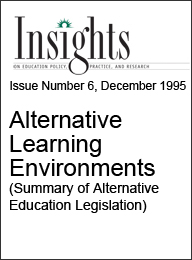Conclusions
Alternative schools can help many students in at-risk situations. If policymakers adopt the alternative education strategy, they should encourage programs to incorporate the features and goals associated with successful programs. In addition, policymakers need to be aware of the issues unique to mandated programs and consider these issues as they craft and revise policies. Whether or not states decide to mandate programs, they must devote attention to the consequences for the rest of the educational system of implementing alternative education programs.
Establishing alternative schools and programs should not divert attention away from the shortcomings of traditional schools. Rather, because effective alternative schools share many features with exemplary schools, policymakers could view the ideal alternative school as a model and use it to inform overall education reform.
In light of the facts that:
- long-term, true educational alternatives represent the most successful kinds of alternative schools;
- many of the features and goals associated with successful programs would benefit all students;
- traditional schools do not effectively serve many (if not most) students; and
- costly alternatives pull money away from the regular schools,
policymakers may want to explore how their states and districts can better spend educational resources. It may be wiser and more effective to reduce the number of students whom the system is failing, rather than create a separate system for only a few of them. This tension between prevention and intervention, separation and mainstreaming, runs throughout education policy decision-making and should not be ignored in the case of alternative education.
In considering whether to encourage and support alternative education and how to revise current legislation, policymakers need to be mindful of their goals and expectations. Do they simply want to help students who are failing, or take a first step towards improving schools for everyone, thus reducing the incidence of failure? If the latter is the goal, policymakers should consider not only which alternative education programs are successful, but also whether the establishment of such programs takes the overall educational system in the desired policy direction.
Next Page: References & Credits

